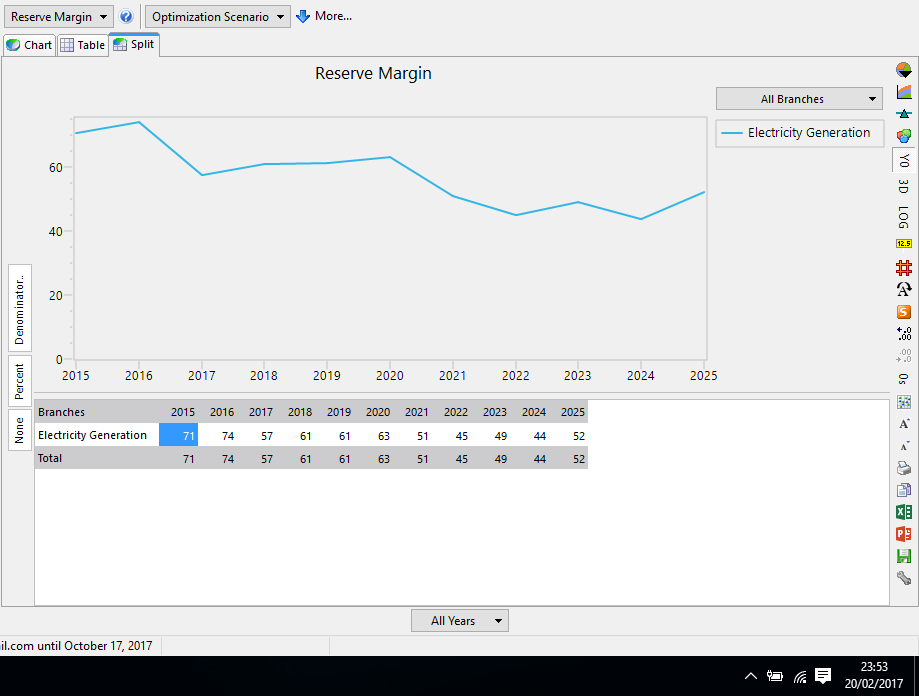Topic: Reserve Margin can not be defined at exact value Subscribe | Previous | Next
Tri Ilham wicaksono 2/20/2017
Greetings,
I have ran and analyzed my model. I set Planning Reserve Margin to 35 (%) to depict situation of the object (because it has to be done with 35 % Reserve Margin). I went to Result section and Transformation > Reserve Margin, and unfortunately, the Reserve Margin values are varying and going far from my value.
As information, The BaseYear electricity generations of my model are far from enough to supply the electricity demand and have the 35% Reserve Margin. However, on next planning year, the Reserve Margin values are varying and far from initial value.
My question, How many parameters that take effects on Reserve Margin calculation and what are they? Because I want to set the Reserve Margin on exact value (to depict my object) and I do not want vary results from Reserve Margin. So that I have to know the parameters that take effect to Reserve Margin calculation.
My question, How many parameters that take effects on Reserve Margin calculation and what are they? Because I want to set the Reserve Margin on exact value (to depict my object) and I do not want vary results from Reserve Margin. So that I have to know the parameters that take effect to Reserve Margin calculation.
Thank you so much for anybody who reply and answer my questions. I really appreciate it.
Best Regards,
Tri Ilham Wicaksono
Hi tri Ilham,
The "Reserve Margin" (http://www.energycommunity.org/WebHelpPro/Results_Categories/Reserve_Margin.htm) in LEAP's Results view is different than the "Planning Reserve Margin" (http://www.energycommunity.org/WebHelpPro/Transformation/Planning_Reserve_Margin.htm) - the former gives the actual reserve margin in each year, while the latter is a data input that LEAP uses as a constraint to ensure that the (actual) Reserve Margin is never lower than the Planning Reserve Margin.
The links posted above also describe how the Reserve Margin is calculated (I've pasted this below but have used slightly different lanuage than is included in the help file):
Reserve Margin (%) = 100 * (Reliable Capacity - Peak Load) / Peak Load
where:
Reliable Capacity = Sum(Capacity * Capacity Credit) for all processes in the module.
As mentioned above, the Planning Reserve Maring constraint is treated as a lower boundary on the reserve margin for the system, which is why your Reserve Margin result flucuates. There is no simple way within LEAP to constrain the reserve margin to a single value in all years.
Taylor
Hi Taylor
Thank you for answering my question. Regarding to your answer, I have another question :
If the definition of Planning Reserve Margin (PRM) is set as the lowest allowed value of Reserve Margin (as a constraint to ensure that the (actual) Reserve Margin is never lower than the Planning Reserve Margin), then,
If the definition of Planning Reserve Margin (PRM) is set as the lowest allowed value of Reserve Margin (as a constraint to ensure that the (actual) Reserve Margin is never lower than the Planning Reserve Margin), then,
Can we set the highest allowed value of Reserve Margin for our model?
Is there any method or clue to do it?
Best Regards,
Tri Ilham Wicaksono
1 Like There is no straighforward way to do this. Also, from the screenshot you posted, I would expect that your existing mix of Exogenous Capacity would immediately violate any maximum reserve constraint, resulting in no solution.
Note that since LEAP + OSeMOSYS builds capacity to achieve a least-cost solution. So there should not be a need to specify such an upper bound on the reserve margin, since LEAP will only construct as much as is needed (taking into account any other constraints you have specified) to meet your Planning Reserve Margin.
Taylor



